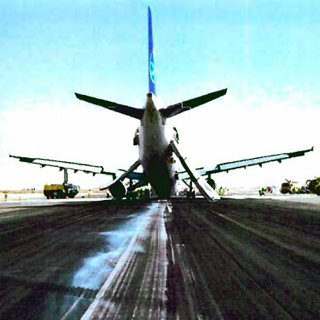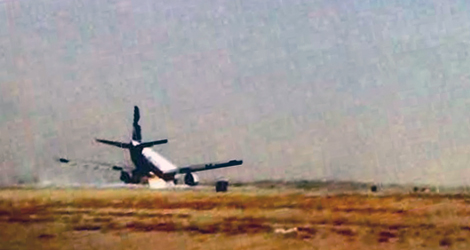
Onur Air flight SVA2865 – Airbus – A300-605R (TC-OAG)
On 01 May 2012, aircraft TC- OAG, an Airbus 300-605R was performing a commercial flight for Saudi Arabian Airlines (SVA) as SVA 2865.
Onur Air flight SVA2865 departed from Prince Mohammed Bin Abdulaziz International Airport (PMAI) Madinah at 08h50 en-route to the King Abdulaziz International Airport (KAIA) Jeddah, Kingdom of Saudi Arabia.
Onur Air flight SVA2865 was on a positioning flight with 10 crew members and no passengers. No discrepancies were noted on this aircraft prior to departure from Madinah. The visibility at Jeddah was good with a few clouds present. During the initial ILS approach to runway 16 Right (16R), while at 8 nautical miles (nm) and 2600 feet (ft), the landing gear handle was lowered.
Both main landing gear extended and locked down and, the nose gear doors opened but the nose landing gear did not lower. The Captain who was then the Pilot Monitoring (PM) took over the controls and carried out a missed approach. The First Officer (FO) became the Pilot Monitoring (PM).
Onur Air flight SVA2865 was then given an area to the northeast of Jeddah to carry out attempts at lowering the nose gear. The flight crew attempted to manually free fall the nose landing gear at least ten (10) times.
The nose landing gear would not lower into the locked position, but the nose gear doors remained open during all those attempts. As a precautionary measure, Onur Air flight SVA2865 performed a fly-by of runway 16R at 500 ft. The air traffic controller confirmed that the nose landing gear (NLG) was not down. SVA 2865 was vectored over the Red Sea to lower the fuel load, thus reducing the landing weight. During this period, the Fire & Rescue Services (FRS) at Jeddah foamed a portion of runway 16 Left (16L) between taxiway Kilo 5 (K5) and K2 (Figure 1). The majority of the FRS vehicles were standing by at the junction of taxiways K4 and K3. SVA 2865 was vectored for an instrument approach for Runway 16L.
The Auto Pilot and the Auto Throttle Systems were OFF. The surface winds were from 220° at 12 knots (kt), gusting to 19 kt and the temperature was + 37 Celsius (°C).
The flight crew used the “Landing with Nose Landing Gear Abnormal” checklist ensuring the aircraft was properly prepared and configured for the approach, the before landing, the flare and the touchdown sequences, including when the aircraft stopped and the necessary procedures to secure the aircraft before evacuation.
Onur Air flight SVA2865 landed on its main landing gear 4000 ft past the threshold of runway 16L .
The nose of the aircraft was slowly lowered to the runway with the nose landing gear doors touching the runway within the foamed area 4500 ft from the end of runway 16L (Figure 2). The front of the fuselage then touched the runway within the last portion of foam, 3500 ft from the end of runway 16L. The nose area of the aircraft slid on the runway, where sparks were present until the aircraft .
As soon as the aircraft passed by the position of the FRS vehicles, the FRS vehicles gave chase to the aircraft and reached it within 30 seconds after it came to a full stop. Although there was no post-crash fire, the FRS personnel applied water and foam to the nose area of the aircraft. All of the crew members were evacuated from the aircraft by ladder provided by the FRS. The crew was taken to the airport clinic as a precautionary measure. All were released the same day.
The accident occurred at 14h49 at KAIA – Jeddah , Kingdom of Saudi Arabia.
Cause Related Findings
- The NLG up-lock contained a spring, Part Number GA71102 that was broken as a result of fatigue initiated at the third coil of the spring.
- The spring had been broken for a prolonged period of time, as noted by the spring linear wear marks on the outside area of the spring coils.
- Damage observed on the NLG up-lock resulted from hard contact with the broken spring during normal NLG operation.
- The fracture process of the spring was initiated at the third coil level. At least 6000 cycles of fatigue (number of striations) have been estimated by fatigue striation measurements. The crack on the spring started on the internal surface of the spring which was not shot peened.
- The normal and free fall extensions of the NLG failed due to a mechanical blockage created by the broken spring jammed against the cam.
Other Findings
- The aircraft was properly certificated and had been maintained in accordance with approved procedures.
- The landing gear free fall cable system was out of tolerance by one (1) turn. This condition did not have an effect on the free fall operation of the landing gear system.
- The meteorological conditions did not contribute to this accident.
- The flight crew was certified and qualified on this type of aircraft.
- The flight crew performed their duties in accordance with the approved procedures.
- All communications with the Jeddah controllers and FRS were satisfactory.
- The FRS response was efficient and appropriate.
- Not all KAIA Airport Operations vehicles were equipped with rotary beacons.
- The Security surrounding the aircraft was inappropriate.
- The angle of the slides situated at the number 3 and 4 doors was beyond 60 degrees with the ground, with only the tip of the slide being self-supporting on the ground.
- The certification of the slides was not specific regarding the useable/recommended slope of the slide in relation to the ground.
- The certification of the slides did not specify what length of the slide should be self-supported on the ground in order to decelerate the fall/sliding of a person.
- At the time of the accident, the Aircraft Inspection Program did not contain a scheduled maintenance action to inspect the springs for condition of the NLG up-lock.
- Effective 20 July, 2012, Airbus released a Mandatory Service Bulletin Number A300-32-6111 for the inspection of up-lock springs.
- Effective 30 July 2013, the European Aviation Safety Agency (EASA) issued an Airworthiness Directive Number (No.) 2013- 0150 due to the reporting of NLG and Main Landing door and uplock spring ruptures on some models of A300, A310 or A-300-600.
Download Report


0 Comments